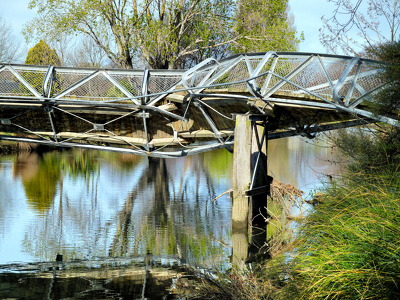
Maps comparing road repairs needed after the 4 September 2010 and 22 February 2011 earthquakes.

A table giving statistics on injuries in the 4 September 2010 and 22 February 2011 earthquakes.

A map showing the extent of liquefaction after the 4 September 2010 and 22 February 2011 earthquakes.

An infographic showing the fault ruptures which caused the 4 September 2010 and 22 February 2011 earthquakes.

A graph showing the number and magnitude of earthquakes between 30 December 2010 and 30 December 2011.

A colour photograph of the north facade of the former Odeon Theatre after the 4 September 2010 earthquake.

A map showing the extent of liquefaction caused by the 4 September 2010 and 22 February 2011 earthquakes.

A photograph of the Observatory tower at the Christchurch Arts Centre, taken before the 2010 and 2011 Canterbury earthquakes.

Graffiti of an angel clutching a bottle, accompanied by the text "Chritchurch (sic) living make a good man drink." The photographer comments, "Living in Christchurch during the earthquakes was hard on all of us. Some people got drunk to forget or blot out the aftershocks, whilst others dare not drink so that they would be in full control just in case another big earthquake/aftershock occurred. As of today 24 September 2011 there has been 8660 earthquakes/aftershocks in the Christchurch area".

A graph showing the number and magnitudes of earthquakes since 4 September 2010.

Charts showing the reduction in visitor numbers to Christchurch following the 4 September 2010 earthquake.

A graph showing the effect the 4 September 2010 earthquake had on investor confidence in Christchurch.

A graphic describing changes Cantabrians have made to their lives following the 4 September 2010 earthquake.

A photograph of an ornamental ceramic handbag with a broken handle.Crack'd for Christchurch comments, "This is where it all started, a piece of Katy Gold pottery, broken slightly in the 4 September 2010 earthquake, totally smashed in the 22 February 2011 earthquake."

Forbe's Store on Norwich Quay, the awning resting on the footpath. Scaffolding placed around the building since the 4 September 2010 earthquake has tumbled during the 22 February 2011 earthquake.

An infographic giving information on events to be held to commemorate the anniversary of the 4 September 2010 earthquake.

The badly twisted Medway Street footbridge. The photographer comments, "The September 4th 2010 earthquake in Christchurch was so violent that the banks of the Avon River moved towards each other. This footbridge being metal had to twist sideways to release the pressure of being pushed from both river banks. It looked like it had been wrung out like a wet towel".

Forbes' Store on Norwich Quay with a broken awning and damage visible on the brick walls. Scaffolding placed around the building since the 4 September 2010 earthquake has tumbled during the 22 February 2011 earthquake.

A digitally manipulated image of broken objects. The photographer comments, "Digital painting of breakages and liquefaction after the February 22 earthquake in Christchurch".

A photograph of TJ's Kasbah in North New Brighton, taken before the February 2011 earthquake. The photographer comments, "Here is what 1 Bowhill Road looked like before the Christchurch earthquake. It was called the Ozone store, which originally was incorporated in the blue Ozone building on the other side of the road".

A photograph of cracks around a window of the Observatory tower at the Christchurch Arts Centre. The cracks formed as a result of the 4 September 2010 earthquake.

A photograph of cracks around a window of the Observatory tower at the Christchurch Arts Centre. The cracks formed as a result of the 4 September 2010 earthquake.

A photograph of cracks in the masonry of the Observatory tower at the Christchurch Arts Centre. The cracks formed as a result of the 4 September 2010 earthquake.

A photograph of cracks around a window of the Observatory tower at the Christchurch Arts Centre. The cracks formed as a result of the 4 September 2010 earthquake.

A photograph of the photocopy template for the Christchurch City Council's green sticker. The sticker was used by the Civil Defence after the 2010 and 2011 earthquakes to indicate that a building had been inspected and that 'no structural or other safety hazards' were found.

A black and white photograph of a pile of rubble in front of a window. In the background behind the window a gap in the building can be seen. The photographer comments, "The result of the Christchurch earthquakes".

A cycle-lane sign submerged in water. The photographer comments, "During the Christchurch earthquake this sign must have dropped off of the pedestrian bridge above and landed straight down into the Avon River".

A sculpture titled 'Passing Time' on the corner of St Asaph Street and Madras Street. 'Passing Time' was installed outside the CPIT Building for the 6th SCAPE (a contemporary public art programme in Christchurch) a few days prior to the 22 February 2011 earthquake. The work features twisting boxes depicting each year between 1906 (the founding of CPIT) and 2010 (the date of the sculpture's production).

A sculpture titled 'Passing Time' on the corner of St Asaph Street and Madras Street. 'Passing Time' was installed outside the CPIT Building for the 6th SCAPE (a contemporary public art programme in Christchurch) a few days prior to the 22 February 2011 earthquake. The work features twisting boxes depicting each year between 1906 (the founding of CPIT) and 2010 (the date of the sculpture's production).

A sculpture titled 'Passing Time' on the corner of St Asaph Street and Madras Street. 'Passing Time' was installed outside the CPIT Building for the 6th SCAPE (a contemporary public art programme in Christchurch) a few days prior to the 22 February 2011 earthquake. The work features twisting boxes depicting each year between 1906 (the founding of CPIT) and 2010 (the date of the sculpture's production).